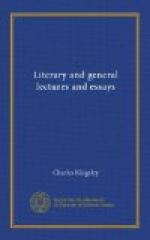But granting, or rather boldly asserting all this, and smiling as much as we choose at the tale of St. Dorothea’s celestial basket, is it not absolutely, and in spite of all, an exquisite story? Is it likely to make people better or worse? We might believe the whole of it, and yet we need not, therefore, turn idolaters and worship sweet Dorothea for a goddess. But if, as we trust in God is the case, we are too wise to believe it all—if even we see no reason (and there is not much) for believing one single word of it—yet still we ask, Is it not an exquisite story? Is there not heroism in it greater than of all the Ajaxes and Achilles who ever blustered on this earth? Is there not power greater than of kings—God’s strength made perfect in woman’s weakness? Tender forgiveness, the Saviour’s own likeness; glimpses, brilliant and true at the core, however distorted and miscoloured, of that spiritual world where the wicked cease from troubling, where the meek alone shall inherit the earth, where, as Protestants too believe, all that is spotless and beautiful in nature as well as in man shall bloom for ever perfect?
It is especially in her descriptions of paintings that Mrs. Jameson’s great talents are displayed. Nowhere do we recollect criticisms more genial, brilliant, picturesque than those which are scattered through these pages. Often they have deeper merits, and descend to those fundamental laws of beauty and of religion by which all Christian art must ultimately be tested. Mrs. Jameson has certainly a powerful inductive faculty; she comprehends at once the idea {210} and central law of a work of art, and sketches it in a few vivid and masterly touches; and really, to use a hack quotation honestly for once, “in thoughts which breathe, and words which burn.” As an instance, we must be allowed to quote at length this charming passage on angel paintings, so valuable does it seem not only as information, but as a specimen of what criticism should be:
On the revival of art, we find the Byzantine idea of angels everywhere prevailing. The angels in Cimabue’s famous “Virgin and Child enthroned” are grand creatures, rather stern, but this arose, I think, from his inability to express beauty. The colossal angels at Assisi, solemn sceptred kingly forms, all alike in action and attitude, appeared to me magnificent.
In the angels of Giotto we see the commencement of a softer grace and a purer taste, further developed by some of his scholars. Benozzo Gozzoli and Orcagna have left in the Campo Santo examples of the most graceful and fanciful treatment. Of Benozzo’s angels in the Ricardi Palace I have spoken at length. His master, Angelico (worthy the name!), never reached the same power of expressing the rapturous rejoicing of celestial beings, but his conception of the angelic nature remains unapproached, unapproachable: it is only his, for it was the gentle, passionless, refined nature of the recluse which stamped itself




